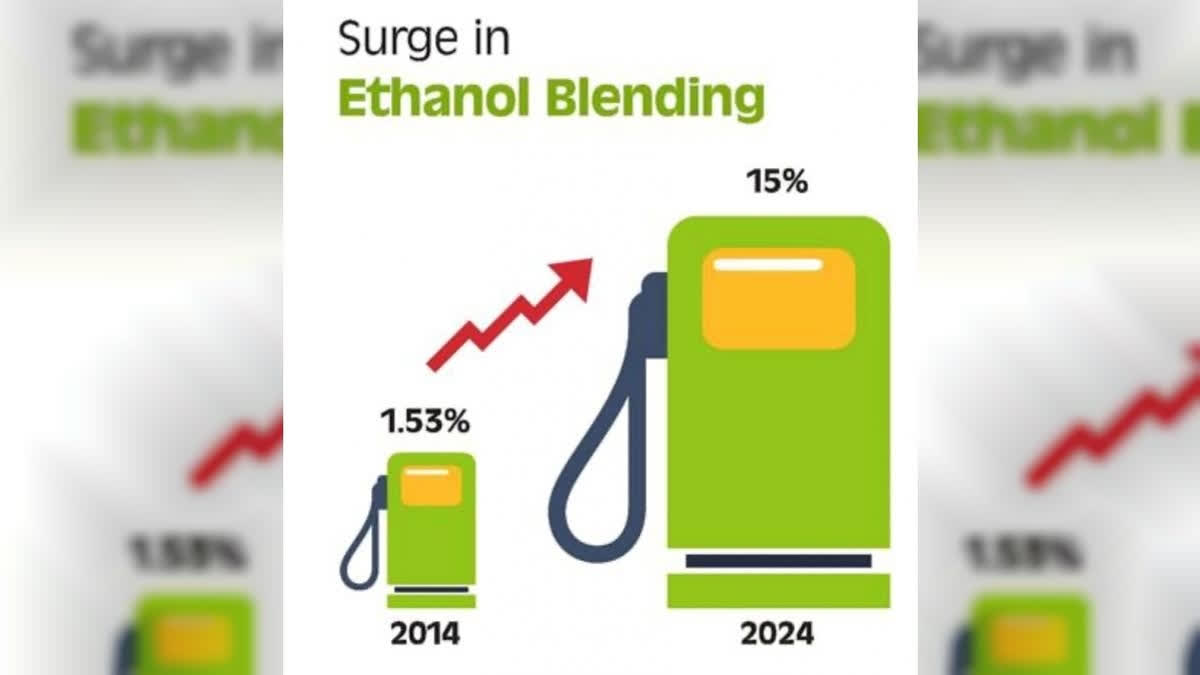New Delhi: India is making bold strides towards energy independence and environmental sustainability by advancing its ethanol-blending targets, officials said.
As the world’s third-largest energy consumer, India has historically relied on imported oil to meet its energy needs. However, with an ambitious ethanol-blending program, India aims to boost rural economies.
The idea of blending ethanol with petrol first began as a pilot project in 2001. Initially slow to gain traction, this initiative has recently gained momentum, backed by government reforms and a commitment to sustainable energy practices. Ethanol, a renewable fuel derived from sugarcane and other biomass, reduces fossil fuel consumption, lowering harmful emissions that contribute to climate change and public health issues.
To expedite this shift, the government has set a target to achieve 20 per cent ethanol blending by 2025, advancing the initial goal from 2030. This decision reflects India's commitment to sustainable energy. During the 7th G-STIC Delhi Conference, Petroleum and Natural Gas Minister Hardeep Singh Puri emphasised India's success in ethanol blending and the government's broader focus on long-term energy solutions.
Ethanol: A Renewable and Versatile Fuel
Ethanol's versatility extends beyond its role as a cleaner fuel alternative. Produced through the fermentation of sugars or by petrochemical processes, ethanol has applications in various industries, including pharmaceuticals and chemical manufacturing. Additionally, it serves as a solvent and plays an essential role in the medical sector as an antiseptic.
India’s rapid economic growth, population expansion, urbanization, and lifestyle shifts have fueled an increased demand for energy. With nearly 98 per cent of the fuel used in road transportation derived from fossil fuels, India's dependency on oil imports presents challenges for both energy security and foreign exchange. Ethanol offers a practical, domestically sourced solution that aligns with India’s environmental and economic goals.
Ethanol production also brings economic benefits to India’s agricultural sector, providing farmers with new income streams. This supports national initiatives such as 'Make in India', the Swachh Bharat Mission, and the goal of doubling farmers’ incomes. Ethanol further promotes the concept of 'wealth from waste', contributing to a more sustainable and circular economy.
Advancements in Ethanol Blending
Under Prime Minister Narendra Modi’s leadership, India has enacted reforms to support energy security, combat climate change, and foster rural growth. The Ethanol Blended Petrol (EBP) Program set an initial target of 20% ethanol blending by 2030, but in 2020, the government moved this goal to 2025.
As of September 2024, India’s ethanol production capacity had doubled within four years to reach 1,623 crore litres. This growth is reflected in blending rates, which rose from 1.53% in 2013-14 to 15% in 2024. In the Ethanol Supply Year (ESY) 2023-24 alone, over 545 crore litres of ethanol were blended, further increasing the national blending percentage to over 13%.
Encouraged by this progress, the government’s push for 20% blending by 2025 has already yielded measurable economic and environmental benefits. Over the past decade, the EBP initiative has saved India ₹1,06,072 crore in foreign exchange, reduced CO2 emissions by 544 lakh metric tons, and replaced 181 lakh metric tons of crude oil.
Furthermore, the program has generated significant economic returns, with Oil Marketing Companies (OMCs) disbursing ₹1,45,930 crore to distillers and ₹87,558 crore to farmers.
Steps to Achieve 20% Ethanol Blending by 2025-26
To meet the 20% target, India will need around 1,016 crore litres of ethanol annually for blending alone, while the overall demand for ethanol across sectors is projected to be approximately 1,350 crore litres. By 2025, the government aims to increase production capacity to about 1,700 crore litres.
Several initiatives are underway to achieve these goals:
Pradhan Mantri JI-VAN Yojana Expansion:
In August 2024, the Union Cabinet extended this scheme until 2028-29 to attract investment and support biofuel production from advanced sources like lignocellulosic feedstocks, agricultural residues, industrial waste, and algae.
Detailed Roadmap for Ethanol Blending:
A comprehensive roadmap outlines steps for implementation, guiding producers, distributors, and regulators.
Expansion of Ethanol Feedstock Sources
Broadening the range of feedstocks used for ethanol production supports efficient and sustainable sourcing.
Favorable Procurement Prices
Fair pricing under the EBP Programme incentivizes ethanol production, benefiting producers and the rural economy.
Reduced GST on Ethanol
To encourage growth, the government reduced the GST on ethanol used in the EBP Programme to 5%.
Facilitating Free Movement of Ethanol
Amendments to the Industries (Development & Regulation) Act enable easier inter-state transportation of ethanol, improving supply chains.
Interest Subvention Scheme
This scheme provides interest subsidies to boost ethanol production capacity, aiding producers in securing financing.
OMCs’ Expressions of Interest
OMCs actively solicit proposals for ethanol procurement, ensuring steady demand and supporting market expansion.
India’s commitment to ethanol blending represents a transformative approach to energy security, environmental sustainability, and economic growth. The government’s proactive measures, including the accelerated timeline for 20% blending by 2025, the JI-VAN Yojana expansion, and a clear roadmap, underscore the country’s determination to harness the full potential of ethanol as a clean energy source.
As India advances in ethanol adoption, the program’s dual benefits, reducing dependence on imported fossil fuels and revitalizing rural economies, stand to create a lasting impact.



